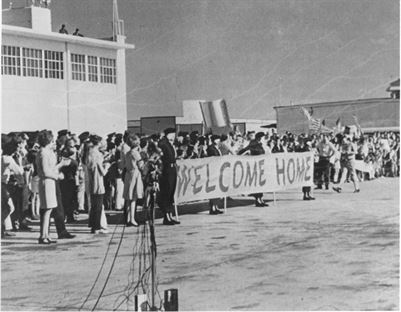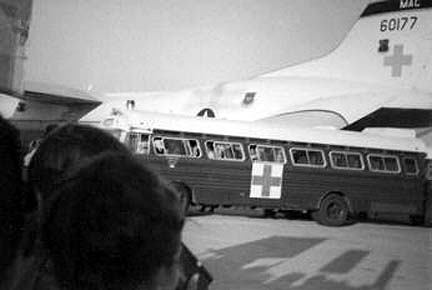
The 50th Anniversary of Operation Homecoming is underway without much fanfare. But for the Prisoners of War (POWs) returning from Vietnam it is an event to be celebrated daily.
Vietnam War
The Vietnam War was long and controversial within the United Sates. It “officially” began after the Gulf of Tonkin Resolution in 1964 under President Johnson. However, President John Kennedy had military advisors in Vietnam before that date. The war temporarily ended in January 1973 with the signing of the Paris Peace Talks Peace Treaty. The North Communist Vietnamese government simply waited two years and re-invaded the democratic South Vietnam, causing it to fall to communist hands on April 30, 1975.
Contrary to popular opinion and press not everyone in the United States opposed the war. Certainly there were highly publicized demonstrations against the war on some streets and many college campuses. However, there were also marches of support, which were not as highly publicized. A number of Americans knew what would happen to the Vietnamese people if the communists took control: There would be a loss of religious liberty, freedom of the press and freedom of speech. This is indeed what happened to Vietnam after the communist took over. Even today there is a limitation on religious and other freedoms.
Who Served and Who was Held
According the Jim Webb (former Senator from Virginia) over 70% of the servicemen killed in Vietnam were volunteers. Those who returned from the war were not always welcomed warmly. My cousin, Marine Ron Stith, among them. This is a wrong that we are just beginning to right in the United States.

One exception to the lukewarm welcome was the greeting that our returning POWs received. Nearly 600 Americans were held captive by the North Vietnamese. In previous wars most POWs had been enlisted men. In Vietnam it was the officers who were held. The vast majority were aviators that had been shot down by Surface to Air Missiles (SAMs) over North Vietnam and been captured and imprisoned.
The Leaders
Some of the more notable captives included former Senator John McCain. McCain declared that he was a raunchy spoiled brat before he was shot down, but the captivity changed him for the better. Robinson (Robbie) Risner and Admiral James Stockdale were US leaders. These were the two highest ranking captives and two men I was fortunate enough to meet later on. Stockdale was most famous after the war for being Ross Perot’s vice presidential running mate in 1992.


John McCain shakes Richards Nixon’s hand (Left) James Stockdale receives the Medal of Honor (Right)
Jeremiah Denton was tortured so badly that he agreed to be interviewed by the North Vietnamese on television “to condemn” Americans. Denton turned the tables on the Vietnamese when he blinked out, “T-O-R-T-U-R-E” in Morse Code during the interview. His blinking helped alert the world to the unbelievable torture these men suffered.
The C-141 Starlifter

All that came to an end on February 12, 1973 when a C-141 Starlifter, tail Number 66-0177 landed in Hanoi to begin Operation Homecoming. The POWs had been allowed to shower and were given new clothes. They decided not to wear the yellow sweaters given by their captors. There had been nothing cheery about their captivity.

The C-141 flew the men from Hanoi to Clark Air Base in the Philippines. As the door closed and they began to taxi, Robbie Risner reports tears filled his and the other men’s eyes. The men received medical attention and warm food in Clark. For some of them it was the first time in seven years they had enjoyed what we take for granted daily. Operation Homecoming was underway
Then on February 14, 1973 the C-141 flew the men to Travis AFB in California. I sat as a young eleven year old boy watching on TV. I was home from school. It was there that I first had the idea that I may want to fly a C-141.
Personal Reflections
I watched in amazement as these men were reunited with their families after years of exile. Operation Homecoming: The emotion still gets to me 50 years later. The photos speak for themselves.

Eight years later I was preparing for “captivity” myself. I was part of SERE (Survival Evasion Resistance Escape) after my Doolie year at the Air Force Academy. Part of the training was three days in a simulated Prisoner of War camp, complete with isolation, interrogation and deprivation. I was in simulation for three days; some of those men were in for real for over three years. To get ready for “The Compound’, as it was known, I read Howard Rutledge’s book, In the Presence of Mine Enemies. Rutledge endured life as a POW in Vietnam for many years.
Most of my instructors at the Academy had served in Vietnam. I had great respect for them. When, as an upperclassman, I served as an integrator I did a simulated interrogation of a cadet by the name of Day. His dad, Bud Day, was a POW in Vietnam who earned the Medal of Honor.

In 1985, as I finished pilot training, I had to put down my choice of aircraft on what was known as a “Dream Sheet”. At the top of my list, was the C-141 Starlifter. Perhaps it all went back to February 1973, 50 years ago, when I saw the C-141, Tail #66-0177 carry those POWs home. Operation Homecoming
For news on what happened to that C-141, Tail 66-0177 see: What Happened

